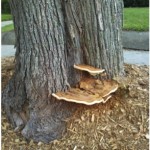Gas Leaks and Soil/Vegetation Dynamics

Ganoderma, a genus of polyspore mushrooms that grow on wood and include about 80 different species, many from tropical areas.
The central question motivating this research is, what are the effects of methane on soils, soil biota, and vegetation at or near leak sites?
Common in most major U.S. cities, pervasive natural gas leaks from urban distribution pipelines provide a unique opportunity to investigate both the impacts of gassed soils on biogeochmical cycling and the novel environment these gassed soils create. Previously unaccounted natural gas leaks in urban environments are quickly gaining attention as a significant source of methane lost to the atmosphere. Beyond its contribution to global warming, elevated methane at leak sites significantly affect above- and below-ground vegetation, as well as on soil composition and soil processes.
Characterizing the effects of natural gas leaks on soils and vegetation is particularly important in light of the role of soils, soil biota, and above- and below-ground biomass in the global carbon cycle and the pervasiveness of leaks in the United States. Likewise, investigation of the unique ecological niche created by gassed soils will tell us something about the ability of methanotrophs and/or methanogens to colonize such environments. They will also tell us more about the adaptability of preexisting microbial communities to methane-rich soils.



